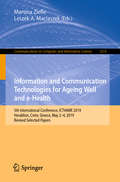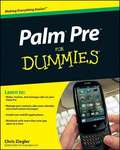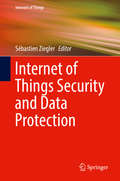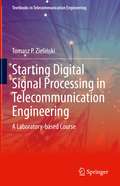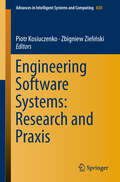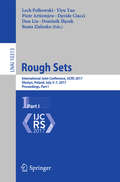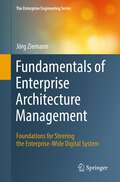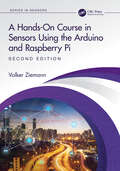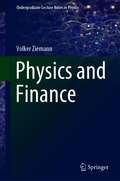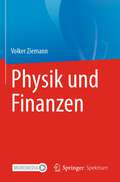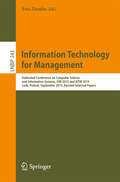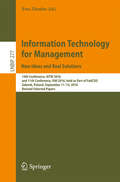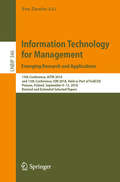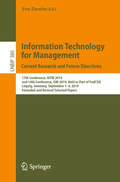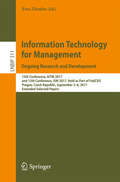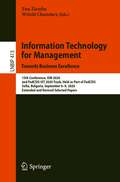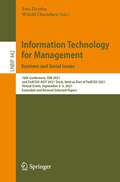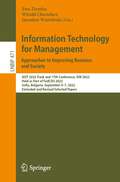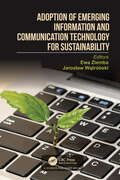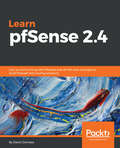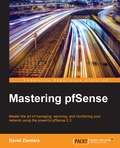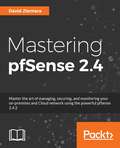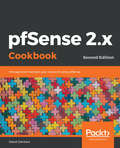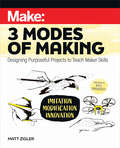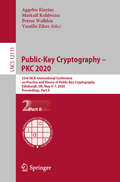- Table View
- List View
Information and Communication Technologies for Ageing Well and e-Health: 5th International Conference, ICT4AWE 2019, Heraklion, Crete, Greece, May 2–4, 2019, Revised Selected Papers (Communications in Computer and Information Science #1219)
by Martina Ziefle Leszek A. MaciaszekThis book constitutes the thoroughly refereed proceedings of the third International Conference on Communication Technologies for Ageing Well and e-Health, ICT4AWE 2019, held in Heraklion, Crete, Greece in May 2019.The 9 full papers presented were carefully reviewed and selected from 52 submissions. The papers aim at contributing to the understanding of relevant trends of current research on ICT for Ageing Well and eHealth including the ambient assisted living.
Palm Pre For Dummies
by Chris ZieglerEverything you need to know to make the most of Palm's newest smartphone Smartphones provide all sorts of communication options as well as the ability to manage your appointments and contacts. If you're new to smartphones, Palm Pre For Dummies gets you up and running easily. If you're a bit more savvy, you can delve deeper into more advanced elements, such as Synergy contact management and working with media. The Palm Pre offers features that make it a top contender in the smartphone market. Its webOS system is designed for a touchscreen-based graphical user interface that facilitates many exciting new features. Palm Pre is a new smartphone specifically engineered for a touchscreen device and loaded with features to maximize the user experience This book helps you take advantage of GPS navigation, games on your phone, and media management Begins with the basics: turning the phone on, making and receiving calls, and storing contacts Covers applications for managing personal information and how Palm Synergy helps manage your communications Shows you how to manage and synchronize e-mail accounts, use the calendar, take advantage of Web site resources, and install new webOS applications Palm Pre For Dummies helps you take full advantage of this new feature-rich device.
Internet of Things Security and Data Protection (Internet of Things)
by Sébastien ZieglerThis book provides an overview of the most recent developments in Internet of Things (IoT) security and data protection. It presents the results of several international research projects addressing this topic from complementary angles. It starts by analyzing the main privacy and security threats on IoT, as well as the evolution of data protection norms, such as the European General Data Protection Regulation (GDPR), and their impact on IoT. Through a comprehensive and systematic approach, the contributors present new perspectives on IoT & Cloud Computing security requirements. They discuss the most recent approach to support trusted IoT, including new models of privacy risk assessment, labeling and certification, and contractual tools (such as Privacy PACT). Practical implementations, such as in the European Large Scale Pilots on IoT for Smart Cities (Synchronicity), are presented, explaining how they address security, privacy and data protection. Finally, innovative models to secure IoT systems are presented for the network and end-nodes security, including network threats analysis.
Starting Digital Signal Processing in Telecommunication Engineering: A Laboratory-based Course (Textbooks in Telecommunication Engineering)
by Tomasz P. ZielińskiThis hands-on, laboratory driven textbook helps readers understand principles of digital signal processing (DSP) and basics of software-based digital communication, particularly software-defined networks (SDN) and software-defined radio (SDR). In the book only the most important concepts are presented. Each book chapter is an introduction to computer laboratory and is accompanied by complete laboratory exercises and ready-to-go Matlab programs with figures and comments (available at the book webpage and running also in GNU Octave 5.2 with free software packages), showing all or most details of relevant algorithms. Students are tasked to understand programs, modify them, and apply presented concepts to recorded real RF signal or simulated received signals, with modelled transmission condition and hardware imperfections. Teaching is done by showing examples and their modifications to different real-world telecommunication-like applications. The book consists of three parts: introduction to DSP (spectral analysis and digital filtering), introduction to DSP advanced topics (multi-rate, adaptive, model-based and multimedia - speech, audio, video - signal analysis and processing) and introduction to software-defined modern telecommunication systems (SDR technology, analog and digital modulations, single- and multi-carrier systems, channel estimation and correction as well as synchronization issues).Many real signals are processed in the book, in the first part – mainly speech and audio, while in the second part – mainly RF recordings taken from RTL-SDR USB stick and ADALM-PLUTO module, for example captured IQ data of VOR avionics signal, classical FM radio with RDS, digital DAB/DAB+ radio and 4G-LTE digital telephony. Additionally, modelling and simulation of some transmission scenarios are tested in software in the book, in particular TETRA, ADSL and 5G signals.Provides an introduction to digital signal processing and software-based digital communication;Presents a transition from digital signal processing to software-defined telecommunication;Features a suite of pedagogical materials including a laboratory test-bed and computer exercises/experiments.
Engineering Software Systems: Research and Praxis (Advances In Intelligent Systems and Computing #830)
by Zbigniew Zieliński Piotr KosiuczenkoThis book highlights a range of new approaches and concepts in the field of software engineering. Based on systematic methods, graphical and formal models, the approaches are designed for solving practical problems encountered in actual software development. The book is divided into 13 chapters, which address core aspects such as security, performance and quality measurement. Chiefly intended to stimulate new research by presenting real problems faced by the industry, and to facilitate software development by applying precisely defined, validated and efficient models and methods, the book offers a valuable guide – for researchers and industry practitioners at small, medium and large companies alike.
Rough Sets: International Joint Conference, IJCRS 2017, Olsztyn, Poland, July 3–7, 2017, Proceedings, Part I (Lecture Notes in Computer Science #10313)
by Beata Zielosko Dominik Ślęzak Dun Liu Davide Ciucci Piotr Artiemjew Yiyu Yao Lech PolkowskiDecision trees and decision rule systems are widely used in different applications as algorithms for problem solving, as predictors, and as a way for knowledge representation. Reducts play key role in the problem of attribute (feature) selection. The aims of this book are (i) the consideration of the sets of decision trees, rules and reducts; (ii) study of relationships among these objects; (iii) design of algorithms for construction of trees, rules and reducts; and (iv) obtaining bounds on their complexity. Applications for supervised machine learning, discrete optimization, analysis of acyclic programs, fault diagnosis, and pattern recognition are considered also. This is a mixture of research monograph and lecture notes. It contains many unpublished results. However, proofs are carefully selected to be understandable for students. The results considered in this book can be useful for researchers in machine learning, data mining and knowledge discovery, especially for those who are working in rough set theory, test theory and logical analysis of data. The book can be used in the creation of courses for graduate students.
Fundamentals of Enterprise Architecture Management: Foundations for Steering the Enterprise-Wide Digital System (The Enterprise Engineering Series)
by Jörg ZiemannThis textbook provides a comprehensive, holistic, scientifically precise, and practically relevant description of Enterprise Architecture Management (EAM). Based on state-of-the-art concepts, it also addresses current trends like disruptive digitization or agile methods. The book is structured in five chapters. The first chapter offers a comprehensive overview of EAM. It addresses questions like: what does EAM mean, what is the history of EAM, why do enterprises need EAM, what are its goals, and how is it related to digitalization? It also includes a short overview of essential EAM standards and literature. The second chapter provides an overview of Enterprise Architecture (EA). It starts with clarifying basic terminology and the difference between EA and EAM. It also gives a short summary of existing EA frameworks and methods for structuring the digital ecosystem into layers and views. The third chapter addresses the strategic and tactical context of the EAM capability in an enterprise. It defines essential terms and parameters in the context of enterprise strategy and tactics as well as the operative, organizational context of EAM. The fourth chapter specifies the detailed goals, processes, functions, artifacts, roles and tools of EAM, building the basis for an EAM process framework that provides a comprehensive overview of EAM processes and functions. Closing the circle, the last chapter describes how to evaluate EAM in an enterprise. It starts by laying out core terminology, like “metric” and “strategic performance measurement system” and ends with a framework that integrates the various measuring areas in the context of EA and EAM. This textbook focuses on two groups: First, EAM scholars, ie bachelor or master students of Business Information Systems, Business Administration or Computer Science. And second, EAM practitioners working in the field of IT strategy or EA who need a reliable, scientifically solid, and practically proven state-of-the-art description of essential EAM methods.
A Hands-On Course in Sensors Using the Arduino and Raspberry Pi (Series in Sensors)
by Volker ZiemannA Hands-On Course in Sensors Using the Arduino and Raspberry Pi is the first book to give a practical and wide-ranging account of how to interface sensors and actuators with micro-controllers, Raspberry Pi and other control systems. The author describes the progression of raw signals through conditioning stages, digitization, data storage and presentation. The collection, processing, and understanding of sensor data plays a central role in industrial and scientific activities. This book builds simplified models of large industrial or scientific installations that contain hardware and other building blocks, including services for databases, web servers, control systems, and messaging brokers. A range of case studies are included within the book, including a weather station, ground-vibration measurements, impedance measurements, interfacing medical sensors to web browsers, the profile of a laser beam, and a remote-controlled and fire-seeking robot. This second edition has been updated throughout to reflect new hardware and software releases since the book was first published. Newly added features include the ESP32 microcontroller, several environmental and medical sensors, actuators for signal generation, as well as a chapter on web sockets; all illustrated in new case studies. This book is suitable for advanced undergraduate and graduate students taking hands-on laboratory courses in physics and engineering. Hobbyists in robotics clubs and other enthusiasts will also find this book of interest. Features: Includes practical, hands-on exercises that can be conducted in student labs, or even at home Covers the latest software and hardware, and all code featured in examples is discussed in detail All steps are illustrated with practical examples and case studies to enhance learning https://github.com/volkziem/HandsOnSensors2ed Volker Ziemann obtained his PhD in accelerator physics from Dortmund University in 1990. After post-doctoral positions in Stanford at SLAC and in Geneva at CERN, where he worked on the design of the LHC, in 1995 he moved to Uppsala where he worked at the electron-cooler storage ring CELSIUS. In 2005 he moved to the physics department where he has since taught physics. He was responsible for several accelerator physics projects at CERN, DESY and XFEL. In 2014 he received the Thuréus prize from the Royal Society of Sciences in Uppsala.
Physics and Finance (Undergraduate Lecture Notes in Physics)
by Volker ZiemannThis book introduces physics students to concepts and methods of finance. Despite being perceived as quite distant from physics, finance shares a number of common methods and ideas, usually related to noise and uncertainties. Juxtaposing the key methods to applications in both physics and finance articulates both differences and common features, this gives students a deeper understanding of the underlying ideas. Moreover, they acquire a number of useful mathematical and computational tools, such as stochastic differential equations, path integrals, Monte-Carlo methods, and basic cryptology. Each chapter ends with a set of carefully designed exercises enabling readers to test their comprehension.
Physik und Finanzen
by Volker ZiemannDieses Buch führt Physikstudenten in die Konzepte und Methoden der Finanzwissenschaft ein. Obwohl die Finanzwissenschaft als recht weit von der Physik entfernt wahrgenommen wird, teilt sie eine Reihe gemeinsamer Methoden und Ideen, die in der Regel mit Rauschen und Unsicherheiten zu tun haben. Durch die Gegenüberstellung der wichtigsten Methoden mit Anwendungen in der Physik und im Finanzwesen werden sowohl die Unterschiede als auch die Gemeinsamkeiten deutlich, was den Studierenden ein tieferes Verständnis der zugrunde liegenden Ideen vermittelt. Darüber hinaus lernen sie eine Reihe nützlicher mathematischer und rechnerischer Werkzeuge kennen, wie stochastische Differentialgleichungen, Pfadintegrale, Monte-Carlo-Methoden und grundlegende Kryptologie. Jedes Kapitel endet mit einer Reihe sorgfältig ausgearbeiteter Übungen, mit denen die Leser ihr Verständnis überprüfen können.
Information Technology for Management
by Ewa ZiembaThis book constitutes revised and extended versions of the best papers from the 10th Conference on Information Systems Management (ISM 2015) and 13th Conference on Advanced Information Technologies for Management (AITM 2015), held in Lodz, Poland, September 2015 as part of the Federated Conference on Computer Science and Information Systems (FedCSIS 2015). These events constitute a forum for the exchange of ideas for practitioners and theorists working in the broad area of information systems management in organizations and to present and discuss the current issues of IT in business applications. The 11 full papers included in this volume were carefully reviewed and selected originally 54 submissions. They focus on knowledge management systems; information technology for business and public organizations; and evaluation of information systems.
Information Technology for Management: New Ideas and Real Solutions
by Ewa ZiembaThis book constitutes revised selected papers from the 14th Conference on Advanced Information Technologies for Management, AITM 2016, and the 11th Conference on Information Systems Management, ISM 2016, held as part of the Federated Conference on Computer Science and Information Systems, FedCSIS, which took place in Gdansk, Poland, in September 2016. The 13 papers presented in this volume were carefully reviewed and selected from 51 submissions. They were organized in topical sections named: information technology and systems for knowledge management; information technology and systems for business transformation; and implementation and evaluation of information systems.
Information Technology for Management: 15th Conference, AITM 2018, and 13th Conference, ISM 2018, Held as Part of FedCSIS, Poznan, Poland, September 9–12, 2018, Revised and Extended Selected Papers (Lecture Notes in Business Information Processing #346)
by Ewa ZiembaThis book constitutes extended selected papers from the 16th Conference on Advanced Information Technologies for Management, AITM 2018, and the 13th Conference on Information Systems Management, ISM 2018, held as part of the Federated Conference on Computer Science and Information Systems, FedCSIS, which took place in Poznan, Poland, in September 2018. The total of 9 full and 3 short papers presented in this volume were carefully reviewed and selected from a total of 43 submissions. The papers selected to be included in this book contribute to the understanding of relevant trends of current research on information technology for management in business and public organizations. They were organized in topical sections named: information technology and systems for knowledge management, and information technology and systems for business transformation.
Information Technology for Management: 17th Conference, AITM 2019, and 14th Conference, ISM 2019, Held as Part of FedCSIS, Leipzig, Germany, September 1–4, 2019, Extended and Revised Selected Papers (Lecture Notes in Business Information Processing #380)
by Ewa ZiembaThis book constitutes extended selected papers from the 17th Conference on Advanced Information Technologies for Management, AITM 2019, and the 14th Conference on Information Systems Management, ISM 2019, held as part of the Federated Conference on Computer Science and Information Systems, FedCSIS, which took place in Leipzig, Germany, in September 2019. The total of 7 full and 6 short papers presented in this volume were carefully reviewed and selected from a total of 45 submissions. The papers selected to be included in this book contribute to the understanding of relevant trends of current research on and future directions of information technology for management in business and public organizations. They were organized in topical sections named: information technology assessment for future development; methods and models for designing information technology, and aspects of implementing information technology.
Information Technology for Management. Ongoing Research and Development: 15th Conference, Aitm 2017, And 12th Conference, Ism 2017, Held As Part Of Fedcsis, Prague, Czech Republic, September 3-6, 2017, Extended Selected Papers (Lecture Notes In Business Information Processing #311)
by Ewa ZiembaThis book constitutes extended selected papers from the 15th Conference on Advanced Information Technologies for Management, AITM 2017, and the 12th Conference on Information Systems Management, ISM 2017, held as part of the Federated Conference on Computer Science and Information Systems, FedCSIS, which took place in Prague, Poland, in September 2017. The 13 papers presented in this volume were carefully reviewed and selected from 48 submissions. They were organized in topical sections named: information technology and systems for knowledge management; information technology and systems for business transformation; and implementation and evaluation of information systems.
Information Technology for Management: 15th Conference, ISM 2020, and FedCSIS-IST 2020 Track, Held as Part of FedCSIS, Sofia, Bulgaria, September 6–9, 2020, Extended and Revised Selected Papers (Lecture Notes in Business Information Processing #413)
by Ewa Ziemba Witold ChmielarzThis book constitutes revised selected and extended papers presented at track 4 of the Conference on Computer Science and Intelligence Systems, FedCSIS 2020, which took place in Sofia, Bulgaria, during September 6–9, 2020. The FedCSIS Information Systems and Technologies Track included AIST 2020, DSH 2020, ISM 2020, and KAM 2020. For this track, a total of 29 submissions was received from which a total of 5 full and 3 short papers was accepted for publication in this volume. The papers were organized in topical sections named: improving project management methods; numerical methods of solving management problems; and technological infrastructure for business excellence.
Information Technology for Management: 16th Conference, ISM 2021, and FedCSIS-AIST 2021 Track, Held as Part of FedCSIS 2021, Virtual Event, September 2–5, 2021, Extended and Revised Selected Papers (Lecture Notes in Business Information Processing #442)
by Ewa Ziemba Witold ChmielarzThis book constitutes revised selected and extended papers presented at track 4 on "Advances in Information Systems and Technologies" of the Conference on Computer Science and Intelligence Systems, FedCSIS 2021, which was held online during September 2–5, 2021. The FedCSIS Track 4 included AIST 2021, DSH 2021, ISM 2021, and KAM 2021. For this track, a total of 30 submissions was received from which a 7 full papers and 1 short papers were accepted for publication in this volume. The papers were organized in topical sections named as follows: Approaches to improving management systems; solutions to social issues; methods for supporting business and society.
Information Technology for Management: AIST 2022 Track and 17th Conference, ISM 2022, Held as Part of FedCSIS 2022, Sofia, Bulgaria, September 4–7, 2022, Extended and Revised Selected Papers (Lecture Notes in Business Information Processing #471)
by Ewa Ziemba Witold Chmielarz Jarosław WątróbskiThis book constitutes revised selected and extended papers presented at track 4 of the Conference on Computer Science and Intelligence Systems, FedCSIS 2022, which took place in Sofia, Bulgaria, during September 4–7, 2022.The FedCSIS Information Systems and Technologies Track included AIST 2022, ISM 2022, DSH 2022, and KAM 2022. AIST 2022 received 11 submissions, from which 2 full papers and 1 short paper have been accepted; for ISM 2022 2 full and 3 short papers have been accepted from 15 submissions; and for DSH 2022 2 full and 1 short papers have been accepted from 11 submissions. From the 17 submissions to KAM 2022, no paper passed the extended reviews, so the overall acceptance rate was 20% for full and 18% for short papers. The papers were organized in topical sections named: Approaches to improving business; approaches to improving society; and methods for improving business and society.
Adoption of Emerging Information and Communication Technology for Sustainability
by Ewa Ziemba JarosławThis book represents an important voice in the discourse on the adoption of emerging ICT for sustainability. It focuses on how emerging ICT acts as a crucial enabler of sustainability, offering new forward-looking approaches to this field. The book explores how emerging ICT adoption drives sustainability efforts in business and public organizations, promoting ecological, economic, social, cultural, and political sustainability. The book's theoretical discussions, conceptual approaches, empirical studies, diverse perspectives, and views make it a valuable and comprehensive reference work. Appealing to both researchers and practitioners, this book provides significant areas for research and practice related to the contribution of emerging ICT adoption to sustainability. It also suggests vital considerations for programming and building sustainable development-driven emerging ICT adoption. Readers will find answers to important contemporary questions, such as: What are the concepts, frameworks, models, and approaches to enhance sustainable development through the adoption of emerging ICT? How does the adoption of emerging ICT influence sustainability? How can emerging ICT be adopted to enhance sustainability? What are the current practices and successful cases of emerging ICT adoption for sustainability? What factors influence emerging ICT adoption to enhance sustainability?
Learn pfSense 2.4: Get up and running with Pfsense and all the core concepts to build firewall and routing solutions
by David ZientaraInstall, Configure and Setup different connections with pfSenseKey FeaturesBuild firewall and routing solutions with PfSense.Learn how to create captive portals, how to connect Pfsense to your https environment and so on.Practical approach towards building firewall solutions for your organizationBook DescriptionAs computer networks become ubiquitous, it has become increasingly important to both secure and optimize our networks. pfSense, an open-source router/firewall, provides an easy, cost-effective way of achieving this – and this book explains how to install and configure pfSense in such a way that even a networking beginner can successfully deploy and use pfSense.This book begins by covering networking fundamentals, deployment scenarios, and hardware sizing guidelines, as well as how to install pfSense. The book then covers configuration of basic services such as DHCP, DNS, and captive portal and VLAN configuration. Careful consideration is given to the core firewall functionality of pfSense, and how to set up firewall rules and traffic shaping. Finally, the book covers the basics of VPNs, multi-WAN setups, routing and bridging, and how to perform diagnostics and troubleshooting on a network.What you will learnInstall pfSenseConfigure additional interfaces, and enable and configure DHCPUnderstand Captive portalUnderstand firewalls and NAT, and traffic shapingLearn in detail about VPNsUnderstand Multi-WANLearn about routing and bridging in detailUnderstand the basics of diagnostics and troubleshooting networksWho this book is forThis book is towards any network security professionals who want to get introduced to the world of firewalls and network configurations using Pfsense. No knowledge of PfSense is required
Mastering pfSense
by David ZientaraMaster the art of managing, securing, and monitoring your network using the powerful pfSense 2.3 About This Book * You can always do more to secure your software - so extend and customize your pfSense firewall * Build a high availability security system that's fault tolerant - and capable of blocking any threats * Put the principles of better security into practice - unlock a more stable and reliable firewall Who This Book Is For SysAdmins and security pros - get more from the world's leading firewall with this book. You can always do more to secure your software, so start here. What You Will Learn * Configure pfSense services such as DHCP, Dynamic DNS, captive portal, DNS, NTP and SNMP * Set up a managed switch to work with VLANs * Use pfSense to allow, block and deny traffic * Make use of the traffic shaper to lower and raise the priority of certain types of traffic * Set up and connect to a VPN tunnel with pfSense * Incorporate redundancy and high availability by utilizing load balancing and the Common Address Redundancy Protocol (CARP) * Explore diagnostic tools in pfSense to solve network problems In Detail pfSense has the same reliability and stability as even the most popular commercial firewall offerings on the market - but, like the very best open-source software, it doesn't limit you. You're in control - you can exploit and customize pfSense around your security needs. If you're familiar with pfSense you probably knew that already. This book builds on any knowledge you may already have, and provides you with a clear route to expand your skills and pfSense's capabilities. You'll learn how to customize and configure pfSense to construct a firewall that can protect you from any potential security threats. Find out how to set up a VPN, and build a high-availability system that provides redundancy and fault tolerance - essential when security and software performance are so interdependent. With further guidance on how to use a diverse range of third-party packages - all of which will help you unlock more from pfSense, this book covers everything you need - and more - to get a high-quality, reliable firewall up and running for a fraction of the cost. Style and approach Practical and actionable, tackle some advanced functionalities of pfSense with minimum fuss. We know you don't just want an instruction manual - you want to put the principles of better security into practice. That's exactly why we produced this book.
Mastering pfSense,: Manage, secure, and monitor your on-premise and cloud network with pfSense 2.4, 2nd Edition
by David ZientaraInstall and configure a pfSense router/firewall, and become a pfSense expert in the process.Key FeaturesYou can always do more to secure your software – so extend and customize your pfSense firewallBuild a high availability security system that’s fault-tolerant – and capable of blocking potential threatsPut the principles of better security into practice by implementing examples provided in the textBook DescriptionpfSense has the same reliability and stability as even the most popular commercial firewall offerings on the market – but, like the very best open-source software, it doesn’t limit you. You’re in control – you can exploit and customize pfSense around your security needs.Mastering pfSense - Second Edition, covers features that have long been part of pfSense such as captive portal, VLANs, traffic shaping, VPNs, load balancing, Common Address Redundancy Protocol (CARP), multi-WAN, and routing. It also covers features that have been added with the release of 2.4, such as support for ZFS partitions and OpenVPN 2.4. This book takes into account the fact that, in order to support increased cryptographic loads, pfSense version 2.5 will require a CPU that supports AES-NI. The second edition of this book places more of an emphasis on the practical side of utilizing pfSense than the previous edition, and, as a result, more examples are provided which show in step-by-step fashion how to implement many features.What you will learnConfigure pfSense services such as DHCP, Dynamic DNS, captive portal, DNS, NTP and SNMPSet up a managed switch to work with VLANsUse pfSense to allow, block and deny traffic, and to implement Network Address Translation (NAT)Make use of the traffic shaper to lower and raise the priority of certain types of trafficSet up and connect to a VPN tunnel with pfSenseIncorporate redundancy and high availability by utilizing load balancing and the Common Address Redundancy Protocol (CARP)Explore diagnostic tools in pfSense to solve network problemsWho this book is forThis book is for those with at least an intermediate understanding of networking. Prior knowledge of pfSense would be helpful but is not required.Those who have the resources to set up a pfSense firewall, either in a real or virtual environment, will especially benefit, as they will be able to follow along with the examples in the book.
pfSense 2.x Cookbook - Second Edition: Manage and maintain your network using pfSense, 2nd Edition
by David ZientaraThis book is intended for all levels of network administrators. If you are an advanced user of pfSense, then you can flip to a particular recipe and quickly accomplish the task at hand, while if you are new to pfSense, you can read chapter by chapter and learn all of the features of the system from the ground up.
Make: Three Modes of Making
by Matt ZiglerThe Maker movement has been an excellent opportunity for people to become producers rather than just consumers, and schools are recognizing the value of offering students the tools, materials, and skills necessary to design sophisticated and meaningful projects. But teaching technical skills should not be the end goal: At its best, a Maker education teaches students to think and act in creative ways that can be applied to difficult challenges in all areas of life.Three Modes of Making provides a framework for Maker courses in upper grades that teach students creative-process skills through three key Maker modes: Imitation, Modification, and Innovation. Educators will learn the differences between the three Maker modes, their associated skill sets, and gain concrete methods to teach, document, and assess these skills. Through this approach, teachers will enable students to apply them to different creative needs.By focusing on how to teach skill development rather than merely how to build specific objects, Three Modes of Making enables students to improve and enhance their creative skills, and learn ways to apply them to a wide variety of challenges. This book is a road map to developing the creative problem solvers that the world needs for the future.
Public-Key Cryptography – PKC 2020: 23rd IACR International Conference on Practice and Theory of Public-Key Cryptography, Edinburgh, UK, May 4–7, 2020, Proceedings, Part II (Lecture Notes in Computer Science #12111)
by Vassilis Zikas Aggelos Kiayias Markulf Kohlweiss Petros WalldenThe two-volume set LNCS 12110 and 12111 constitutes the refereed proceedings of the 23rd IACR International Conference on the Practice and Theory of Public-Key Cryptography, PKC 2020, held in Edinburgh, UK, in May 2020. The 44 full papers presented were carefully reviewed and selected from 180 submissions. They are organized in topical sections such as: functional encryption; identity-based encryption; obfuscation and applications; encryption schemes; secure channels; basic primitives with special properties; proofs and arguments; lattice-based cryptography; isogeny-based cryptography; multiparty protocols; secure computation and related primitives; post-quantum primitives; and privacy-preserving schemes.
